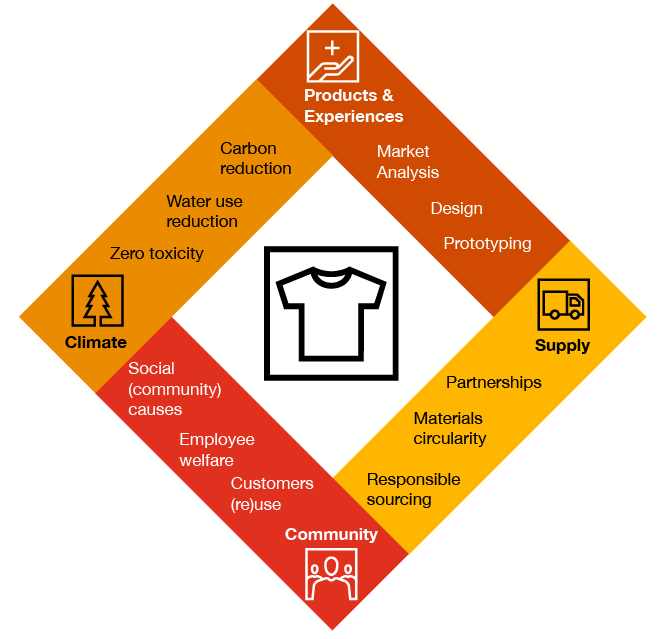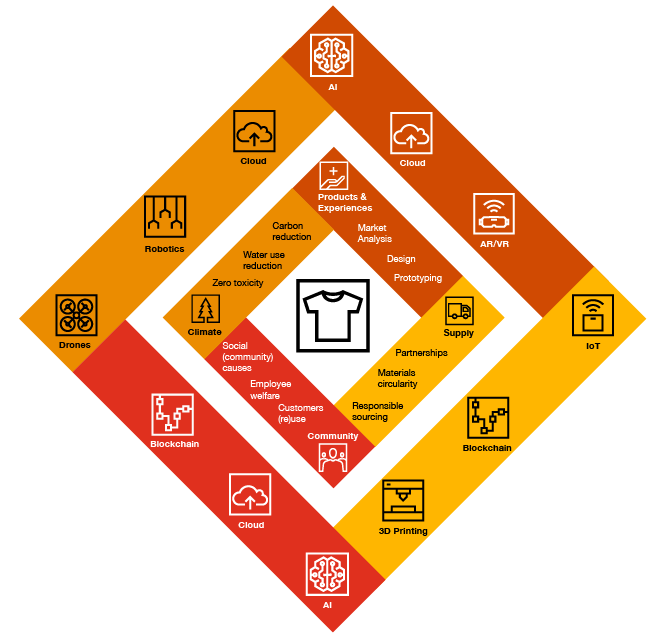PwC research shows that consumers have become increasingly interested in sustainable fashion during the COVID-19 crisis. The ability of fashion brands to measure their sustainability metrics in a credible and transparent way and share them with consumers and stakeholders has become progressively critical. What role can emerging digital technologies play in enabling both the creation of sustainable value as well as its measurement and disclosure? And what new opportunities will arise by combining AI, AR/VR, the cloud, blockchain and IoT, for example?
With a global market value of 1.5 trillion euros, of which 340 billion euros in Europe, the fashion industry is one of the largest in the world. As the third largest industrial consumer of water, the sector has a profound impact on the environment. It also produces 10% of global greenhouse gas emissions and disposes of more than 1,500 (mostly toxic) chemicals.


Change drivers
Based on PwC’s 2020 Global Consumer Insights Survey, the good news is that an increasing number of consumers are keen to understand the environmental impact of their fashion purchases and also expect companies to care for the planet and take proactive action. While 43% of global respondents said they expected businesses to be accountable for their environmental impact before the pandemic, the consumer focus on sustainable business practices surged during the COVID-19 crisis. More than a year into the pandemic, the recent pulse of our 2021 Global Consumer Insights Survey shows that 55% of respondents globally and 44% in the EU are actively choosing products with a traceable and sustainable origin.
At the same time, COVID-19 has encouraged experimentation, coaxing consumers to explore different digital ways to access products and services. A significant percentage of consumers in the survey say that they have increased their use of digital channels and interactions in their own digital/mobile shopping activities.
Staying competitive
To cultivate a seamless, end-to-end, customer shopping experience that attracts and retains sustainability-minded customers, fashion companies have adapted their business models to weave sustainability into their strategy and digitalisation into their operations. This creates a formula for success to stay competitive in the market.
Prior to the pandemic, the fashion industry was already in the process of digitally innovating and transforming its back, middle and front office. Sustainability was also already in the mix as companies opportunistically sought to be more eco-friendly. In the course of navigating the health crisis, digital innovation was placed front and centre, quickly accelerating as a way to keep businesses going in a time of social distancing measures. It also made the global population aware of a looming environmental crisis, which in turn prompted businesses to deliberately try to be more sustainable throughout their value chain. On top of this, fashion companies need to ‘prove themselves’ by measuring and disclosing ‘the level of sustainability’ in a credible and transparent way to an increasing number of their stakeholders, including resellers, consumers, suppliers and investors.

What makes a fashion company sustainable?
For fashion companies to ‘prove themselves’ and enable long-term sustainability, it is fundamental that they define, measure and monitor the performance of quantifiable metrics that support their key ambitions on the following four dimensions:
Products and experiences
To be successful in the market, fashion companies need to ensure that they create the right products and experiences for their target consumers. This relates to all product design and research activities (including prototyping) and all business activities spanning the customer journey (including marketing, sales, pricing, delivery and service). Applying a sustainability lens to these activities can contribute to ambitions such as waste reduction, optimised productivity and promotion of sustainable commercial models. A couple of trending examples in the fashion industry are:
- Experimenting with new materials when it comes to research and innovation activities (for example, brands like New Balance and VF Corporation are trying out leather alternatives such as Piñatex, which is made of pineapple leaf fibres and Camira is collaborating with the SEAQUAL Initiative to create fabrics made from waste found in the oceans);
- Reducing waste production on the design side by making design and prototyping processes less material intensive; and
- Shifting towards resale and/or rental business models, with the total second-hand market projected to grow to almost twice the size of fast fashion by 2029.
Dimension |
Key ambition examples |
Sample metrics (KPIs) |
|---|---|---|
Products and experiences |
|
|
Supply chains
The end-to-end materials flow in the value chain and ambitions related to waste reduction are key elements to address in terms of a sustainable supply chain. So is the ethical sourcing of raw materials, an area associated with key suppliers, the working conditions and wages they offer and compliance with child labour prohibitions. Fashion brands are becoming more critical of their supply chains and expect suppliers to be more transparent about the sustainability of their facilities, raw materials and/or products & services. Examples include:
- Fruit of the Loom, a major brand that focuses on balancing the needs of the business with the impact on the people involved in its supply chain. It does this by ensuring that suppliers protect workers’ rights under labour and social security regulations and take measures to mitigate their ecological impact.
- The Queen of Raw marketplace is reducing waste by offering a service to enterprise sellers aimed at helping them find waste in their supply chains in real-time. They can automatically send inventory to Queen of Raw and sell the excess fabric instead of depositing the material in a landfill. This is an approach which reduces waste while still generating an element of profit.
Dimension |
Key ambition examples |
Sample metrics (KPIs) |
|---|---|---|
Supply |
|
|
Community (People and Culture)
With some sources estimating the total workforce in the fashion and textile industries at over 430 million,i.e. 1 in 8 workers globally, the steps fashion companies are taking to improve employee well-being and business culture with regard to diversity and equal employment, can have a far-reaching impact. This can be further supplemented by the contribution these companies make to social issues by means of community welfare activities, partnerships with NGOs and charitable foundations. Examples include:
- H&M launched its Layers programme to educate both corporate executives and employees on how a lack of diversity impacts business. The programme encourages discussion and reflection on how to support employees of colour.
- Lacoste addresses social issues by partnering with the International Union for Conservation of Nature (IUCN). It created a special clothing line in which its crocodile logo was temporarily replaced by ten different animal species threatened with extinction. Proceeds of this collection went to IUCN to protect wildlife worldwide.
Dimension |
Key ambition examples |
Sample metrics (KPIs) |
|---|---|---|
Community (People & Culture) |
|
|
Climate
As described earlier, the fashion sector has a profound impact on the climate with its excessive use of natural resources, large amount greenhouse gas emissions and chemical waste. This means that fashion companies can go a long way in making an impact in the battle against climate change by reducing energy consumption (and therefore greenhouse gas emissions), water use and the toxicity of waste throughout the value chain. Firms exploring ways to contribute in this respect include:
- Levi’s, which has launched a new Water<Less clothing line that uses up to 96% less water.
- Stella McCartney, which is ensuring that products primarily use organic cotton (significantly reducing water use and avoiding toxic chemicals). The company is also experimenting with carbon farming, which prioritises the restoration of soil health, enhances biodiversity and increases the soil’s ability to store water and carbon. To further promote these topics, Stella McCartney is collaborating with other (fashion) brands, including multiple partnerships with Adidas to develop eco-friendly collections and a joint partnership with Burberry and Kering aimed at improving the environmental footprint of Italy’s luxury fashion supply chain.
Dimension |
Key ambition examples |
Sample metrics (KPIs) |
|---|---|---|
Climate |
|
|
While the above metrics provide a good basis for measuring sustainability performance aligned with ambitions, collecting sustainability data and metrics is not an end in itself. The use of these metrics enables fashion companies to communicate their level of sustainability in a transparent and credible manner to all stakeholders, including investors, partners and consumers. It also helps fashion companies to continue to innovate and improve their sustainability performance as a whole.
In addition, multi-brand retailers can use these metrics to ensure that the brands they sell or partner with are truly sustainable. They do this by requesting the actual performance metrics from their suppliers both during and after the selection process. Doing this on a continuous basis ensures that suppliers continue to invest in sustainability. The use of these metrics by retailers, platforms and investors then creates a ripple effect which can permeate further down the supply chain and into other industries, increasing the overall impact.
The role of digital
Technological innovation is the backbone for the development of sustainability in the fashion industry and plays a significant role in measuring and improving sustainability-related metrics across all four sustainability dimensions. PwC has identified various emerging technologies that will have the greatest impact on business over the next three to five years. These technologies drive new processes, communication channels and ways of working, and enable a better use of resources. This in turn facilitates a company’s ambitions and provides support in measuring and communicating how they create sustainable value in a credible and transparent way. The versatile uses of these technologies range from AI to improve efficiency and customer intelligence to additive manufacturing, which has the potential to disrupt the fashion supply chain and drastically reduce its environmental impact. Technologies such as blockchain and IoT can be combined to enable a significant improvement in the level of supply chain transparency.
While any technology on its own can enable sustainability, it is the convergence of technologies that yields powerful business solutions for the fashion industry and facilitates the measurement of sustainability at the same time.

A few examples of how the fashion industry can leverage digital in their sustainability journey:
- Fashion supply chain transparency and trust
- Digital fashion
- Fashion B2C eCommerce platforms
- New (in-store) fashion retail experiences
- Other emerging technology applications
Fashion supply chain transparency and trust
To automate trust and transparency, technologies such as blockchain, IoT, the cloud and AI work together to ensure the authenticity of data, verify identities, enable secure multi-party transactions and enable measurement of sustainability. For example, IoT sensors can track a fashion product from farm (sourcing) to factory (production) to warehouse (distribution) and ultimately to the shop. Every transaction in the materials flow can be recorded and authenticated in this manner and in a secure, unchangeable blockchain.
Together, IoT and blockchain create an immutable supply chain, ensuring that buyers get an authentic product that has not been damaged along the way and also enabling the attachment of a ‘digital birth certificate’. These certificates hold all the sustainability and supply chain transparency-related data of a product, enabling it to be resold, recycled or reused. It also gives every item a digital identity passport, showing where products come from and where they go during their lifecycle.
An example of real-world use of such technology is the CircularID™ Protocol developed by Eon, which outlines all the data that should be attached to a product, enabling it to be resold or recycled. Eon is working with global brands and retailers to introduce connected products with CircularID so they can be managed sustainably across their lifecycle. Guarantee of authenticity is also a useful tool against counterfeiting, a scourge in an industry which is notorious for its poor labour conditions and ignorance of sustainability standards.
Digital fashion
Digital fashion is the latest trend at the intersection of fashion and technology. It leverages on a combination of technologies, including AR/VR, AI, the cloud and blockchain, to create various use cases. Examples include the way retailers and brands are using 3D files along with AR/VR to create virtual showrooms that significantly shorten the duration of the entire sample process, reduce waste and lower the carbon footprint through less travel. The company Voor3D has multiple virtual showrooms where clients can display their garments in 3D. In addition, virtual fitting rooms on SnapChat and Instagram – using AR technology to ‘try on’ make-up, eyewear, jewellery, shoes and bags – are also being deployed by brands such as Dior and Gucci, making the technology more mainstream.
Fashion B2C eCommerce platforms
The emergence of e-commerce platforms enables recommerce, rentals and the return of fashion products. These platforms use a combination of AI, the cloud and blockchain to enable brands and consumers with the same sustainability values to come together and scale up the advantages of new rental, reuse and resale fashion business models. See our article on recommerce models for more information on this trend.
New (in-store) fashion retail experiences
Combining emerging technologies helps to change and recreate retail experiences that give people a purpose to visit, and create a stronger connection to the brand promise. For example, by scanning the IoT-enabled identity tag on a garment, consumers can see the whole supply chain of the garment in a virtual or augmented reality experience. AI-driven algorithms could provide retailers with more levers to pull in order to influence consumer behaviour. For instance, when a consumer arrives at an online store, the store’s app can register their arrival and send them notifications about new sustainable fashion lines or products tailored to their buying habits.
Automation will also continue to reshape the retail experience, as inventory-checking robots and drone delivery move beyond the conceptual stage and become more commonplace, making both logistics and inventory management more streamlined and less resource intensive. Finally, advances in 3D printing could see a first step into the future, where a consumer could walk into a retailer, choose and experience an outfit using AR/VR and then order a physical garment which is immediately produced by a 3D printer at the retailer. This eliminates the environmental impact of the entire supply chain. Feetz is a company that already offers customised 3D-printed shoes produced without water and made from recycled material that is also recyclable. Customers can send their shoes back to Feetz when they no longer wish to wear them. The material is then recycled to create a new pair of 3D-printed shoes.
Other emerging technology applications
AI will be the pervasive technology of the fourth industrial revolution and has perhaps the greatest potential to support the sustainability ambitions of fashion companies. Firstly, AI can increase productivity, which is an essential part of a circular economy. It can also help make systems more efficient by optimising the use of resources like energy and water. The World Economic Forum foresees a role for AI in interpreting data and identifying patterns from satellite imagery and sensors, which are used to decrease over-irrigation of cotton farms, thereby increasing the cotton yield and quality. In addition, AI speeds up the process of learning and understanding, accelerating scientific discovery on the materials innovation side. It also enables improved customer analytics and demand forecasting, reducing unnecessary stock and waste. An example of innovative use of AI is Dutch start-up Project Cece, which uses a visual AI engine to allow users to find and buy sustainable versions of the items they want simply by uploading photos of them.
Advances in robotics enable manufacturers to deploy robots in an increasing number of applications, eliminating the human error that can lead to waste. By applying robotics to production processes, companies can increase yields and reduce waste, as well as extend a product’s life by increasing quality. For example, Grabit has made robots with which Nike is now experimenting. Designed for fabric stacking, these Stackit robots can accurately position all parts of a sneaker upper in 50 to 75 seconds – a task that can take a human worker more than ten minutes to complete. This not only increases the efficiency of the manufacturing process, but also makes the process less labour-intensive and reduces the incentive to employ (and often exploit) low-wage workers in developing countries.
Effective application of emerging technologies to create value requires a business to embrace digital technology and digitise (parts of) its business value chain. Cloud computing is one of the technologies that enables this digitalisation process, helping businesses to respond more nimbly to changing trends and innovate faster with fewer resources. For instance, leveraging cloud computing allows businesses to adopt other trends such as AI and IoT to create sustainable value while also reducing their carbon footprint by moving IT operations from data centres to a public cloud provider.
Bringing it to life: the Relevé Fashion case
Shopping with a purpose
The Relevé Fashion retail platform offers products from sustainable and ethical fashion brands while telling the many-sided story of sustainability and making a social impact. PwC’s digital innovation & transformation director, Jennifer Nelen, and Consumer Markets business development manager, Maxine Borja, talk to Relevé Fashion’s founder and CEO, Raia Gomez, and Chief Business Officer, Bea Antonio, about their platform and its sustainability message to the market.


















